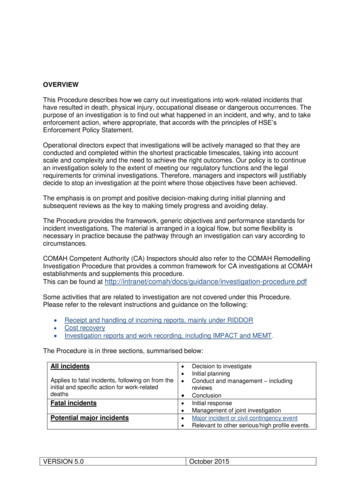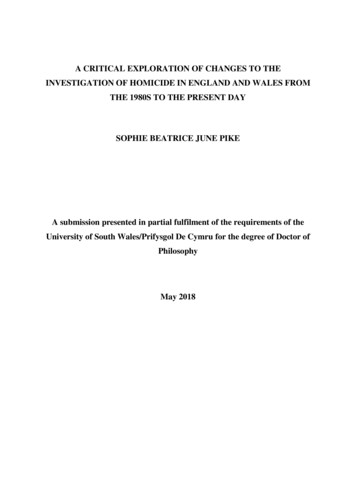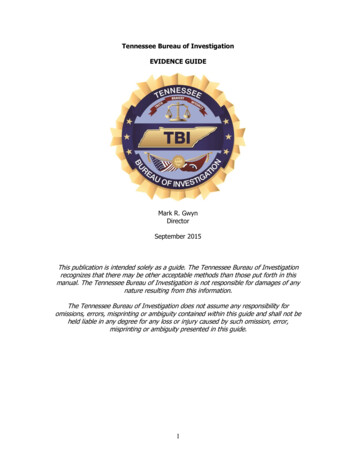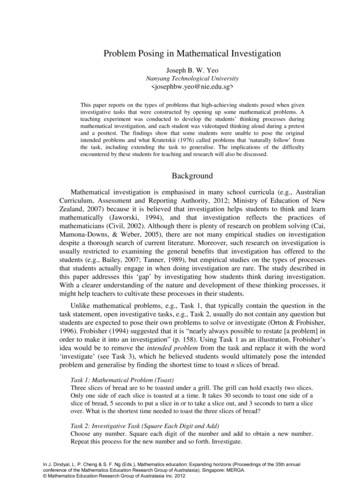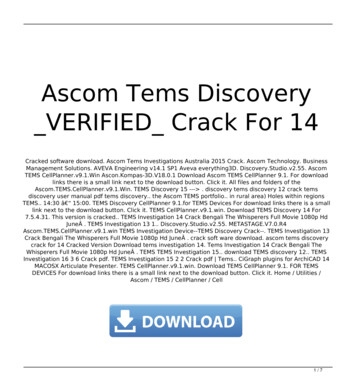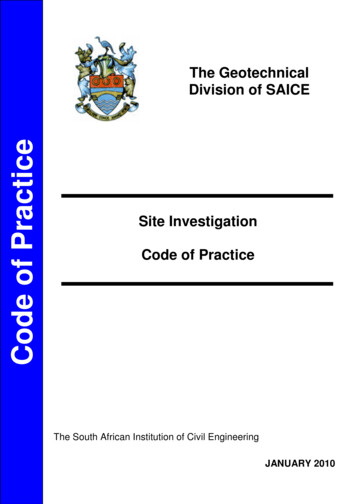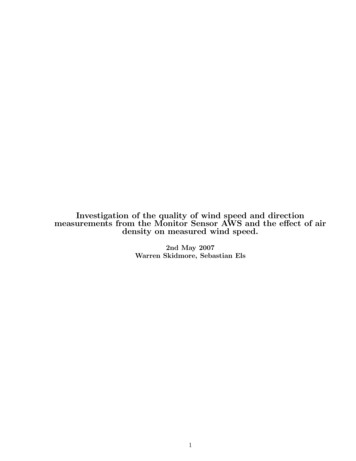
Transcription
Investigation of the quality of wind speed and directionmeasurements from the Monitor Sensor AWS and the effect of airdensity on measured wind speed.2nd May 2007Warren Skidmore, Sebastian Els1
Contents1 Introduction1.1 The purpose of this document . . . .1.2 Overall sensor layout . . . . . . . . .1.3 Description of the AWS . . . . . . .1.4 Description of the sonic anemometer.33334.5556910.1212121316161617171718184 The dependence of measured wind speed on real wind speed and density4.1 Cup anemometer operation assumptions . . . . . . . . . . . . . . . . . . . . . . . . . .2020A Wind speed and direction assessment software21.2 Wind speed2.1 Assessment of AWS anemometer operation . . . . . .2.1.1 Summary of configuration file notes and on site2.1.2 Comparison with sonic anemometer . . . . . .2.1.3 Statistical analysis . . . . . . . . . . . . . . . .2.2 Long term time line of wind speed data quality . . . . . .work. . . . . . . . . . .reports. . . . . . . . . . . . .3 Wind direction3.1 Assessment of wind vane operation . . . . . . . . . . . . . . . . . . . . . . . .3.1.1 Comparison with sonic anemometer . . . . . . . . . . . . . . . . . . .3.1.2 Summary of configuration file notes and on site work reports . . . . .3.2 Correction factors and uncertain periods for the wind direction measurements3.2.1 T1-Tolar . . . . . . . . . . . . . . . . . . . . . . . . . . . . . . . . . . .3.2.2 T2-Armazones . . . . . . . . . . . . . . . . . . . . . . . . . . . . . . .3.2.3 T3-Tolonchar . . . . . . . . . . . . . . . . . . . . . . . . . . . . . . . .3.2.4 T4-SPM . . . . . . . . . . . . . . . . . . . . . . . . . . . . . . . . . . .3.2.5 T6-Hawaii . . . . . . . . . . . . . . . . . . . . . . . . . . . . . . . . . .3.3 Correction of the T2-Armazones AWS wind direction measurements . . . . .3.4 Effects of the dome on the wind flow at the sonic anemometer . . . . . . . . .B Sonic anemometer wind direction calculation with respect to internal coordinatesystem222
Chapter 1Introduction1.1The purpose of this documentThis document is not intended to be a final report regarding the accuracy and calibration of the windspeed and direction measurements collected during TMT site testing. It is a working document forthe TMT sites group and is available for use when processing and analysing wind speed and directionmeasurements from the sites and interpreting these results. The quality of measurements from thesites can be assessed using the methods outlined in this document, the sites group monitors the operation of the wind sensors accordingly and carries out maintenance work as necessary to ensure thebest possible data quality.Some knowledge of the sites, the site testing equipment and the measurement aims of the site testinggroup are assumed for readers of this report.1.2Overall sensor layoutAt the TMT candidate sites listed in Table 1.1, a Monitor Sensors Automated Weather Station (AWS)and a CSAT3 sonic anemometer have been installed. The location of the sonic anemometer on the 7mtower and the location of the AWS with respect to the tower are also listed in Table 1.1. The sonicanemometers are oriented to point away from the dome and can be at either end of the side of thetower on which they are attached (see Figure 2.3 of [1]). The top horizontal cross member of the AWSunits are all oriented approximately East-West. Listed in Table 1.1 is a distance and approximatebearing of the AWS from the centre of the base of the 7m tower.1.3Description of the AWSThe Monitor Sensors AWS are equipped with a cup anemometer and a wind vane (see [1]). The presentsensor readings are read out through a data logger and stored in a file on the Supervisor Computerevery 2 minutes 1 . The wind speed readings are supposed to be 1 minute averages from the previousminute, but the sensor settings have not always been consistent. In the worst case the readings wereaveraged over a few seconds. All AWS systems were systematically setup in 2006 09 and very fewsignificant changes were necessary to any of the AWS sensor settings. It is not possible to change,check or set the wind direction sensor settings, so the averaging period is not known. However allcandidate sites are equipped with the same type of wind direction sensors, so all data are equivalent.1At sites where a 30m tower is installed (T2 as of 2006 09, T3 as of 2007 03), the sensors are read every 60s3
Table 1.1: The TMT candidate sites and details of the sonic anemometer location and orientationat the 7m level on the telescope tower and AWS orientation and location with respect to the centreof the tower base. Note: The T4 sonic anemometer is positioned further from the dome than at theother sites, the AWS was moved by 2005 10 31 (possibly one or two days before that date) from 170 o12m to the present location. Trees around the T4 site were cut down on 2005 09 waii1.4Altitude2290m3064m4480m2830m4050mSonic anemometer location/orientationWest side south endNorth side east endSouth side west endSouth side west endSouth side east endAWS location280 o 10m45 o 10m0 o 10m110 o 10m0 o 10mDescription of the sonic anemometerThe CSAT3 sonic anemometers give a continuous 60Hz output of the three dimensional wind vectors,Vx , Vy , Vz and sonic temperature Ts [1]. These measurements are averaged in to 60 second bins andthe horizontal wind speed and direction are calculated. The write time of the sonic anemometer measurement and the AWS measurement is the same. The sonic anemometers were installed, positionedand oriented to point in to the prevailing wind or, as in the case at T6, to be perpendicular to the twomain wind directions so as to minimise the effect of the dome. The CSAT3 heads are approximately1.3m from the dome, except for the T4 unit that is about 2m from the dome. See [1] for a moredetailed description.4
Chapter 2Wind speed2.1Assessment of AWS anemometer operationFirst we include a summary of all known wind speed calibration measurements and sensor changes,services and operational observations. Then we look at how the weather station wind speed measurements compare to those from the sonic anemometers placed on the 7m tower. We describe how thiscomparison appears in the cases where the AWS wind speed sensor is fine and when it is affectedby problems with the bearings around the vertical axis. Finally we describe the development of astatistical method to assess the effect of problems with the AWS wind speed sensor on the wind speedmeasurements. We list the results of this method for all data collected up until this date.2.1.1Summary of configuration file notes and on site work reportsBelow are extracts of site calibration reports that concern wind speed measurements. On site comparison measurements with the AWS are made using an SM28 hand held weather station [2, 3]. Windspeeds are in 0060103080810101102070726092829071810160505AWS 22 -8 SM28 15 -5AWS 18 -3 SM28 17 -3AWS 30SM28 33AWS 13.64 SM28 13.9AWS wind speed sensor giving lots of zero values (noticed 2005 10 10)17:20:04 Wind speed sensor changedAWS 26.9 SM28 30 -4AWS 17 -1 SM28 11.5 -1AWS 11.2 SM28 12.0AWS 10.5 SM28 0303030824303105071124AWSAWSAWSAWSAWSAWSAWS36 -227 -715 -108 -238 -240 -1032.59SM28SM28SM28SM28SM28SM28SM2832 -327 -38 -52 -238 -238 -534.45
2006 022006 042006 072006 072006 082006 1051 Km/H2007 0312 AWS 75SM28 6017 AWS anemometer squeaking04 AWS 29.2SM28 26.104 AWS 24.1SM28 25.019 SM28 WS 21.0 K/HR (16:04 local)15 SM28 WS 56.7 Km/H (14:58 local), 65.0 Km/H(18:32 local)02 Wind speed sensor bearings replaced(15:00 6200636.42006200711 19 AWS 11.6SM28 9.201 28 AWS 13.5 -1.8 SM28 12.6 -102 01 Wind speed units confirmed to be km/h02 18 AWS 37 -2SM28 35 -503 28 Wind speed sensor changed, old one apparently not rotating smoothly07 06 Wind speed sensor changed07 06 AWS 26.8SM28 2407 06 AWS 26.5SM28 2208 17 SM28 21.2 - 25 Km/Hr (13:02 local), 27.4 K/Hr (15:50 local),K/Hr Max 47.3 K/Hr Average 36.5 K/Hr (17:05 local)10 06 AWS wind speed sensor makes squeaking noises03 09 Wind speed sensor bearings replacedT4-SPM2006 02 23 AWS 13.4 SM28 11.22006 01 25 20:52UT AWS anemometer replaced (old sensor left for comparison 21AWS 9.2SM28 9.7 -0.2Wind speed units confirmed to be km/h20:26:06UT AWS anemometer replacedAWS 13.92 SM28 13.1Comparison with sonic anemometerThe sonic anemometer and AWS are physically in different locations and at different altitudes (7m(close to the telescope) and 2m, respectively). We expect the wind speed to be greater at the altitude of the sonic anemometer by some factor, but in general if there is wind at the AWS then thereshould be wind at the sonic anemometer and vice versa. The difference in wind speeds is describedby a multiplicative factor that has some dependence on wind direction due to the local topographyand structures, this factor is not strictly known for any of the sites. For the purposes here it is notnecessary to know it as long as we can assume that its absolute value is always roughly 1 regardlessof wind direction. Its value is expected to be around V 2m /V7m 0.7 (this value is an approximationbased on discussions with Konstantinos Vogiatzis about his wind flow models).There is no expectation that the sonic anemometer ever reads zero wind speed in a non-zero wind. Ifwe ignore local effects of the dome and topography on the wind flow, the multiplicative wind speedfactor mentioned above encompasses any incorrect calibration factors between the AWS and sonic6
Figure 2.1: Plots of the sonic wind speed minus the AWS wind speed versus the sonic wind speed fortwo months from T3-Tolonchar. Blue points are daytime, purple points are nighttime. Left: Duringthis month there is no evidence that the AWS anemometer is sticking or stiff, there is no evidencethat the AWS anemometer is underestimating the wind speed. The mean slope indicates that thesonic anemometer measures proportionally higher wind speeds due its higher location, as expected.Right: This month shows that often the AWS anemometer is measuring zero wind speed when thesonic anemometer measures high wind speeds. Also note the much poorer correlation of AWS andsonic wind speed, evidenced by the increased scatter of points. Thus there is evidence that the AWSanemometer has a mechanical problem.anemometer.The mechanical AWS anemometer has to overcome internal friction before it registers any wind (seeSection 4.1). This internal friction should be low, so the number of zero wind speed points should alsobe low. The AWS anemometer’s manufacturer’s specification is for a startup wind speed of 0.36km/h[1]. A disproportionately high number of zero wind speed points from the AWS anemometer indicatesa probable problem, as does a strong deviation from a simple form of multiplicative relation betweenAWS wind speed and sonic wind speed.If the above assumptions are correct, then we can check for periods when the AWS anemometer has amechanical problem that affects its ability to rotate, such as when the vertical rotational axis bearingbecomes stiff, by plotting the difference in speeds (V sonic VAWS ) versus the wind speed measuredby the sonic anemometer. A plot of the difference in speeds versus the wind speed should on averagehave a positive slope (as the sonic anemometer, being higher, measures higher wind speeds) that goesthrough the origin. A clear 45 line will extending well above several km/h indicates that the AWSanemometer is sticking.Scripts and code were written that downloaded all AWS and sonic anemometer data from all sites andcreated the type of plots mentioned in the paragraph above (V sonic VAWS vs Vsonic ), one new plotfor each month. Examples of these comparison plots are shown in Figure 2.1. Table 2.1 lists the sitesand months during which an assessment of the AWS anemometer operation has been made.7
Table 2.1: The sites and dates for which the sonic anemometer/AWS comparison allows the AWSanemometer operation to be assessed. When a plot of the wind speed difference vs sonic anemometerwind speed is inspected, OK means that the AWS anemometer appears to be working fine, BADmeans that there is strong evidence that the AWS anemometer is sticking in low wind speeds andmeasuring below the real wind speed, POOR means that there is a lot of scatter. All months listedfor T2-Armazones show a majority of points indicating good operation of the AWS anemometer butthe plots show a lot of scatter. The ratio values are derived as described in Section 2.1.3.MonthT1Ratio T2Ratio2005 12 2006 01 2006 02 OK27.9POOR 4.82006 03 OK4.1BAD1.52006 04 OK6.6BAD2.32006 05 OK15.7POOR 6.42006 06 OK5.7POOR 9.22006 07 OK13.9POOR 28.32006 08 BAD 0.30BAD2.52006 09 BAD 0.84BAD0.962006 10 2006 11 2006 12 2007 01 2007 02 2007 03 2007 04 1). T6- one population of points looks OK2). T6- a second population is clearly off3). T3- one population of points looks OK4). T4- one population of points looks OK5). T3- one population of points looks OK6). T6- sensor replaced in early Dec otes12345,6
2.1.3Statistical analysisThe periods where we have overlapping wind speed measurements with the AWS and the sonicanemometer only cover relatively short sections of the full AWS data sets. Several years of AWSmeasurements have no simultaneous sonic anemometer measurements. The method of manual comparison with the sonic anemometer in Section 2.1.2 is thus limited in its time coverage. We requireda more quantitative method of defining whether we could consider AWS wind speed data to be goodor bad, a method that would not be biased during periods of calm or harsh conditions. So a methodbased on the statistical distribution of wind speeds was developed.The distribution of wind speeds is expected to follow a standard statistical distribution, generally alog normal distribution. But independent of the form of the wind speed distribution we always knowthe wind is never exactly zero, that at low wind speeds, well below the mean or median wind speed,the number of points in each wind speed bin will increase as the bin wind speed increases and mostmeasurements approach the mean or median wind speed.We derived the following statistical method for assessing whether the distribution of wind speeds wassimilar to that expected, i.e. the AWS anemometer has low internal friction, or whether there wasevidence of high friction in the AWS anemometer causing a disproportionately large number of zerowind speed points.For a particular period of AWS measurements (all analysis in this report uses month-long periods):1). Determine the mean wind speed and standard deviation around the mean for all non-zero measurements.2). Set a wind speed bin width of Vmean5 .3). Count the number of zero wind speed measurements and the number of finite measurements inthe first bin (greater than 0 and less than or equal to Vmean5 ).4). Report the ratio of the number of points in the first bin to those with zero wind speed.The ratios for the corresponding examples from T3-Tolonchar in Figure 2.1 are 7.3 for 2006 05 and0.54 for 2006 07. Corresponding ratios are reported in Table 2.1 for those months with simultaneoussonic anemometer measurements. By comparing the ratios and manual assessments (Section 2.1.2) inTable 2.1 we see that higher ratios correspond to ‘OK’ assessments of the AWS anemometer operation,low ratios occur when the AWS wind speed sensor is ‘BAD’. For the reported ratios in Table 2.1, onlyAWS wind speed measurements that were coincident with CSAT3 sonic anemometer measurementswere included in the calculations.The effect of having a disproportionately large number of points with zero wind speed on the measuredmean wind speed is quantified using the following method:1). Determine the mean wind speed including and excluding points with zero wind speed, i.e. determine Vnonzero and Vall .2). Take the difference of the mean wind speeds ( V V nonzero Vall ) to get a velocity shift, dividethe shift by the two mean values, Vnonzero and Vall , separately to get a relative shift for the non-zerowind speeds and all wind speed cases.Figure 2.2 shows the ratio of the number of points in the lowest wind speed bin over the number ofzero wind speed points against the relative shift on the mean wind speed in the left plot and medianwind speed in the right plot. A clear anti-correlation exists between the statistical ratio and relative9
Figure 2.2: Left: Plot of the relative shift of mean wind speed versus ratio of number of points inlowest wind speed bin over number of points of zero wind speed. Green points are for wind speeddifference over mean of all non-zero wind speeds, red points are for difference over mean of all windspeeds. Right: Same plot for median speeds.effect on the mean and median wind speeds. The horizontal lines indicate the 10%, 5% and 1% effects,the vertical lines and the vertical axis indicate corresponding bin ratios of 0.6, 1 and 4 (blue, cyanand purple) respectively. We can say that, for a ratio of 1, the effect on both the mean and medianwind speeds is about 5%. Green points are for wind speed differences divided by the mean (left handpanel) or median (right hand panel) calculated using the all non-zero wind speeds, red points arefor all wind speed measurements. signs are for all months on all sites (see Table 2.2), squaresare for those points in Table 2.1 that are labelled as OK, stars are for points labelled BAD (pointslabelled POOR are omitted). The stars and squares fall within the same body of points as the signs.A conclusion could be that for months with ratios below 1.0 that we can say the wind speed measurements may be significantly biased or affected by problems with the AWS wind speed sensor thatcause an underestimation of the wind speed by a maximum of 5%. The relation of relative shift andratio only give an upper limit on the bias because some zero wind speed measurements occur duringwinds lower than the specified start up wind speed for a normally functioning anemometer [1]. In2006 09, an AWS-AWS comparison at T2-Armazones ([5]) showed that the AWS anemometer usedfor all measurements in this report compared very well to a second brand new new cup anemometer.The ratio for the original AWS anemometer measurements during this month was 7.1.2.2Long term time line of wind speed data qualityThe full listing of the ratios for all AWS data so far obtained is listed in Table 2.2. These ratiosinclude all AWS wind speed measurements and are shown in Figure 2.2 against the relative effect as symbols. The equivalent ratios in Tables 2.1 and 2.2 are almost equal in most cases. The ratiosin Table 2.1 are calculated using only those AWS wind speed measurements with simultaneous sonicanemometer measurements, the amount of sonic anemometer data can be small during the first andlast month of operation and the sonic anemometers have sometimes had significant down times, sothere are some explainable inconsistencies.10
TableMonth2003 102003 112003 122004 012004 022004 032004 042004 052004 062004 072004 082004 092004 102004 112004 122005 012005 022005 032005 042005 052005 062005 072005 082005 092005 102005 112005 122006 012006 022006 032006 042006 052006 062006 072006 082006 092006 102006 112006 122007 012007 022007 032007 042007 052.2: List of all months of AWS wind speedT1-Tolar T2-Armazones 290.6220280.57167.52327.9-11measurements and their statistical ratios.T4-SPM 0.160.100.110.620.221.30.800.683.61.3152.8-
Chapter 3Wind direction3.1Assessment of wind vane operationThe operation of the AWS wind direction sensor and wind vane is expected to be less affected bymechanical problems than the wind speed measurements. If the vertical axis bearing is stiff then theresponse of the wind vane will be slightly slower in low wind speeds but on average there should beno difference when compared to a new wind direction sensor.The problems with the wind direction sensors are dominated by alignment issues (both alignment errorsat the time of installation and alignment changes when the locking bolts on the sensor body comeloose), incorrect wind direction offset parameters and incorrect application of the offset parameters.The sonic anemometer software simply outputs the results of the analysis of the raw sonic anemometerdata stream relative to the internal coordinate system [1]. This has to be corrected later dependingon the orientation of the sonic anemometer on the telescope tower. No correction was carried outduring the analysis reported in this document and the expected offset is listed in Table 3.1. TheAWS wind direction measurements are modified by a wind angle parameter, this has been zero atall sites except T2-Armazones and the history of this parameter and configuration tests are listedSection 3.1.2. The WIND ANGLE offset is added to the AWS wind direction measurement by theweather script on the supervisor computer as the script reads out the AWS and the values are added tothe weather station.[SITE].[DATE] file. No record of the unmodified wind direction measurementis made.3.1.1Comparison with sonic anemometerCorrelation plots of month-long segments of the AWS and sonic anemometer wind direction measurements show the stability of the two instruments and demonstrate whether their respective measurements agree. Table 3.1 lists the months that give a consistent offset, numbers in bold indicate thatthe offset between AWS and sonic anemometer wind direction is as expected based on the orientation of the sonic anemometer and, in the case of T2-Armazones, on the wind angle offset parameter.The error in the alignment estimations of the AWS wind direction sensors and sonic anemometersfrom correlation plots is 8 . Up until 2006 03 27, the logic used to derive the sonic anemometerwind direction was incorrect, after this time the software on all sites was updated to give correctwind directions. All analysis reported here includes recalculated sonic anemometer wind directions,measurements in the TMT sites database are not correctly calculated [as of the time of writing thisreport]. The logic used to calculate the wind direction is detailed in Appendix B. Measurements ofthe sonic wind direction made before 2006 03 27 should be recalculated from the V x and Vy velocitycomponents in the sonic anemometer results files.12
The internal coordinate system of the sonic anemometer [1] is such that when facing north into awind from the north, the output reading will be 270 , i.e. a 90 degree offset should be added to theoutput from the CSAT3 analysis software. See Figure 2.2 in [1], if north is to the right in the negativex direction and the wind is from the north, the output will be 270 .To correct the sonic anemometer horizontal wind direction to true north, apply the offset values inTable 3.1 (sonic-AWS) to the calculated wind direction as shown in Equation (3.1).θtrue θmeasured offset3.1.2(3.1)Summary of configuration file notes and on site work reportsSummarised notes of calibration measurements, checks and changes of the WIND ANGLE parameterand instrument installation and orientation notes for the five sites are listed below. The originalinformation came from a variety of sources, mainly from Sebastian Els’s AWS calibration notes,Warren Skidmore’s configuration status files, from the archives of the software and configuration files,the CTIO site testing memos and from old emails. The AWS calibration measurements are the outputof the weather script on the SC unless otherwise noted, times are in UT.T1-Tolar2003 04 10 AWS first installed on Tolar2005 01 26 AWS 227 -10 Compass 236 -102005 03 09 AWS 305 -5Compass 308 -52005 08 28 AWS 190.65Compass 1982005 08 28 WIND ANGLE 02005 08 29 AWS 343.22Compass 3432005 11 10 AWS 193Compass 190.52006 02 16 AWS 333 -5Compass 340 -52006 02 16 Sonic anemometer installed pointing west2006 03 23 WIND ANGLE 02006 03 29 Sonic anemometer software modified to give wind direction w.r.t.direction unit is pointing2006 07 05 AWS 1.2Compass 0T2-Armazones2003 12 17AWS 210 Compass 02004 11 06 Standard AWS operations begin2005 01 03 18:30-33 AWS 248 Compass 250[2005-01-23 20:18:02 wind direction adjusted for sensor error direction is now -210from the original direction] - from electronic note on batman, date stamp 2005 10 242005 01 23 20:10:02 WIND ANGLE correction parameter implemented. -210 added to AWSwind vane output when written.2005 01 24 21 00AWS 160 Compass 1622005 01 31 12 15AWS 360 Compass 5windgusts2005 03 05 19 07AWS 350 Compass 350 low wind2005 03 11 09:35AWS 358 Compass 2gusts13
Table 3.1: The mean approximate offset (sonic anemometer direction minus AWS direction) for eachmonth of simultaneous AWS and sonic anemometer data and the expected offset if WIND ANGLE 0.Bold values are those consistent with the sonic anemometer orientation and wind angle offset parameteraccording to the notes in Section 3.1.2. Estimates on the values of the offsets are accurate to withinabout 8 . Also listed are dates of commencement of AWS measurements as part of the TMT sitessystem and the start and end dates of the AWS/sonic anemometer overlap periods.MonthStart dateOverlap startOverlap endOffset (sonic-AWS)2005 122006 012006 022006 032006 042006 052006 062006 072006 082006 092006 102006 112006 122007 01T1-Tolar2003 10 112006 02 162006 09 10000000000-T2-Armazones2004 11 062006 02 112006 09 09-906055202025-90-85-90-T3-Tolonchar2005 11 172006 03 309080100085809090909090T4-SPM2004 10 022006 05 06907080757570808080-T6-Hawaii2005 06 282005 11 ). T6-Hawaii has periods with fixed AWS direction2). T2-Armazones very chaotic3). T4-SPM has a lot of noise in all months4). T2-Armazones has minor population at -55. T3-Tolonchar has minor population at 805). T2-Armazones has lesser population at 120 and very few points at -20. T3-Tolonchar has a lesserpopulation at 06). T6-Hawaii has periods with fixed AWS direction14
2005 05 18 14:25AWS 320 Compass 3202005 05 18 14:25AWS 326 Compass 3352005 08 03 First mention of WIND ANGLE -210 in site-config archiveFrom archives: site-config.T2-Armazones.20050803: WIND ANGLE -210 before this date2005 08 24 12:52AWS 224 Compass 17 [From minicom - consistent with AWS-210]2005 09 10 WIND ANGLE -2102005 11 04 13:36AWS 155.22-155.35 Compass 156.92006 02 11 - sonic data starts, sonic pointing north2006 02 12 15.45AWS 210 Compass 2102006 03 23 WIND ANGLE -2102006 03 27 - sonic software update, instrument plots before this date not correct2006 03 29 Sonic anemometer software modified to give wind direction w.r.t.direction unit is pointingFrom archives: site-config.T2-Armazones.20060330:WIND ANGLE -210 before this date2006 03 31 - Offset noted after correction of AWS-sonic -30 deg2006 04 03 15 45-50 AWS 140 Compass 112 offset because sensor body loose,tightened screw2006 04 03 17 05AWS 139 Compass 110 offset because sensor body loose,tightened screw2006 04 03 17 10AWS 222 Compass 192 offset because sensor body loose,tightened screw2006 04 03 - direction of the sonic OK -5 to 10 deg.2006 04 03 WIND ANGLE -240 updated from -210 (set incorrectly for a short time to -180)2006 04 04 Noted that WIND ANGLE correction not being applied for some time before this date2006 04 04 WIND ANGLE changed from -240 to 30 [LOOKS LIKE THIS SHOULD HAVE BEEN 120 NOT 30]From archives: site-config.T2-Armazones.20060404: WIND ANGLE -240 before this dateFrom archives: site-config.T2-Armazones.20060405:WIND ANGLE 30 before this date2006 06 06 WIND ANGLE changed from 30 to 0From archives: site-config.T2-Armazones.20060607:WIND ANGLE 30 before this date2006 07 03 - Offset noted of AWS-sonic -15 deg2006 07 04 On site inspection - Sensor body at 25 degrees east of north. Vane connectedat 250 degrees with respect to fiducial mark. Orientation of wind vane corrected,measures 0 when pointed North 17:45 UTFrom archives: site-config.T2-Armazones.20060715: WIND ANGLE 0 before this dateFrom archives: Date stamp 2006 11 18 site-config WIND ANGLE 02006 12 07 22.08AWS 357.34 Compass 0T3-Tolonchar2005 11 19 AWS 188.8Compass 1902005 12 29 WIND ANGLE 02006 01 28 AWS 1.7 -1.0 Compass 0.02006 02 18 AWS 323Compass 320 -52006 02 19 Sonic anemometer installed pointing south2006 03 29 Sonic anemometer software modified to give wind direction w.r.t.direction unit is pointing2006 04 05 AWS sensor rotated to match the sonic anemometer15
2006 07 06AWS 358Compass 0 Measurements made after rotating unit to 1305300723AWS 210 -2Compass 208 -4Trees cut down around siteAWS back on line after lightning damageAWS moved and telescope operations restartedSonic anemometer installed pointing south but not collecting dataInstrument computer fixed and sonic taking dataT6-Hawaii2005 06 28 Wind vane set to give 0 when pointing North (checked with GPS)2005 07 12 Wind direction senso
A Wind speed and direction assessment software 21 B Sonic anemometer wind direction calculation with respect to internal coordinate system 22 2. . eration of the wind sensors accordingly and carries out maintenance work as necessary to ensure the best possible data quality. . The TMT candidate sites and details of the sonic anemometer .





